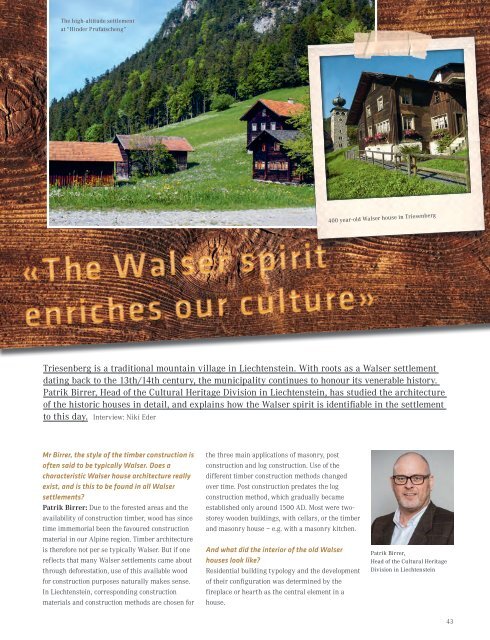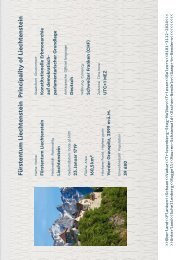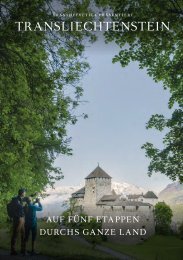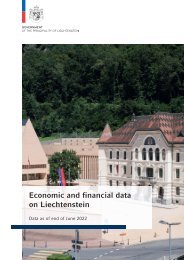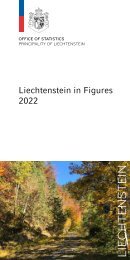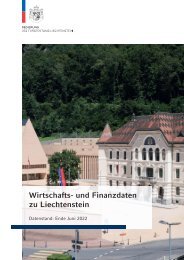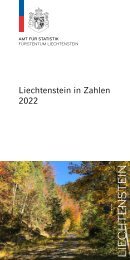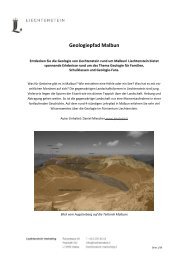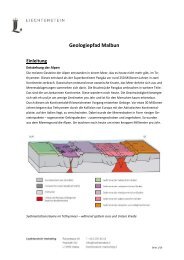oho #3 - The magazine of the Principality of Liechtenstein
The Liechtenstein magazine takes you onto a journey through the country. Find out more about the state, the Princely House, the nature, the culture, the economy and more.
The Liechtenstein magazine takes you onto a journey through the country. Find out more about the state, the Princely House, the nature, the culture, the economy and more.
Create successful ePaper yourself
Turn your PDF publications into a flip-book with our unique Google optimized e-Paper software.
<strong>The</strong> high-altitude settlement<br />
at “Hinder Prufatscheng”<br />
<strong>oho</strong><strong>#3</strong><br />
400 year-old Walser house in Triesenberg<br />
Triesenberg is a traditional mountain village in <strong>Liechtenstein</strong>. With roots as a Walser settlement<br />
dating back to <strong>the</strong> 13th/14th century, <strong>the</strong> municipality continues to honour its venerable history.<br />
Patrik Birrer, Head <strong>of</strong> <strong>the</strong> Cultural Heritage Division in <strong>Liechtenstein</strong>, has studied <strong>the</strong> architecture<br />
<strong>of</strong> <strong>the</strong> historic houses in detail, and explains how <strong>the</strong> Walser spirit is identifiable in <strong>the</strong> settlement<br />
to this day. Interview: Niki Eder<br />
Mr Birrer, <strong>the</strong> style <strong>of</strong> <strong>the</strong> timber construction is<br />
<strong>of</strong>ten said to be typically Walser. Does a<br />
characteristic Walser house architecture really<br />
exist, and is this to be found in all Walser<br />
settlements?<br />
Patrik Birrer: Due to <strong>the</strong> forested areas and <strong>the</strong><br />
availability <strong>of</strong> construction timber, wood has since<br />
time immemorial been <strong>the</strong> favoured construction<br />
material in our Alpine region. Timber architecture<br />
is <strong>the</strong>refore not per se typically Walser. But if one<br />
reflects that many Walser settlements came about<br />
through deforestation, use <strong>of</strong> this available wood<br />
for construction purposes naturally makes sense.<br />
In <strong>Liechtenstein</strong>, corresponding construction<br />
materials and construction methods are chosen for<br />
<strong>the</strong> three main applications <strong>of</strong> masonry, post<br />
construction and log construction. Use <strong>of</strong> <strong>the</strong><br />
different timber construction methods changed<br />
over time. Post construction predates <strong>the</strong> log<br />
construction method, which gradually became<br />
established only around 1500 AD. Most were twostorey<br />
wooden buildings, with cellars, or <strong>the</strong> timber<br />
and masonry house – e.g. with a masonry kitchen.<br />
And what did <strong>the</strong> interior <strong>of</strong> <strong>the</strong> old Walser<br />
houses look like?<br />
Residential building typology and <strong>the</strong> development<br />
<strong>of</strong> <strong>the</strong>ir configuration was determined by <strong>the</strong><br />
fireplace or hearth as <strong>the</strong> central element in a<br />
house.<br />
Patrik Birrer,<br />
Head <strong>of</strong> <strong>the</strong> Cultural Heritage<br />
Division in <strong>Liechtenstein</strong><br />
43


